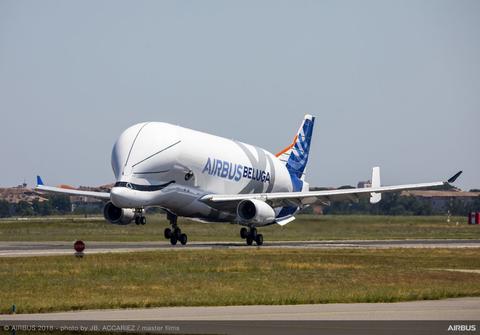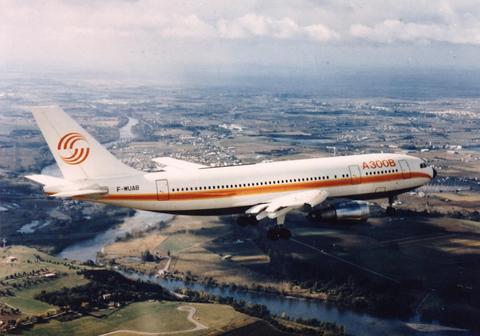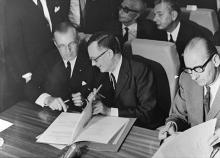Airbus is maintaining its commercial aircraft market leadership in 2018. Building on the company-record 718 jetliners delivered in 2017, the 1,109 net orders logged during the preceding 12 months, and an industry-record 7,265 aircraft on its order books at year-end. Key achievements so far this year include milestone first deliveries (A350-1000, Ultra Long Range A350 XWB and A330-900); introduction of the A220 into Airbus’ single-aisle aircraft family; maiden flight of the BelugaXL super airlifter; and more.
A380 developments for customers around the world
Emirates, already the largest airline customer of the double-deck Airbus A380, recommitted itself to the iconic jetliner with the January signing of a memorandum of understanding for the acquisition of 20 A380s and an option for 16 more. Deliveries are to start in 2020.
From this carrier’s first A380 delivery through late 2017, Emirates had received 100 of the flagship jetliners.
In another development, Portugal’s Hi Fly began offering an A380 for ‘wet lease’ beginning in mid-year 2018 under arrangements that provide the aircraft with its crew, maintenance and insurance. The A380 offered for lease by Hi Fly is a second-hand aircraft previously flown by a scheduled airline, and is from the inventory of Doric GmbH as the asset-owner and lessor to Hi Fly.
All Nippon Airways (ANA) will be the first Japanese customer for the world’s largest passenger aircraft, and the carrier’s first of three A380s rolled out of the Airbus paint shop in Hamburg, Germany during December. This jetliner features the airline’s distinctive Hawaiian sea turtle livery – one of the most elaborate painted by Airbus. ANA is to take delivery of its first A380 in 2019.
Capitalising on the popularity of the iflyA380 website, Airbus released a mobile iOS app version in January. Making flying aboard the spacious A380 a matter of choice rather than chance, both the website and app allow users to browse all available A380 flights and select one of the 53 worldwide destinations served by the flagship jetliner. With the desired departure city, destination and travel dates chosen, booking is finalised through the selected airline at no additional cost. The app further enhances the onboard experience, immersing travellers in Apple’s augmented and virtual reality functionalities.
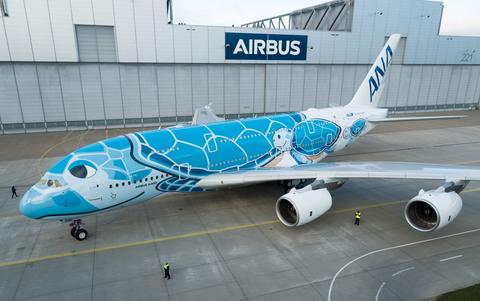
Ten years of the A380 at Heathrow Airport
In March, Airbus celebrated 10 years of A380 operations at Heathrow Airport – which is the world’s busiest in terms of the number of operators flying the flagship aircraft to and from this major international destination.
Singapore Airlines, the first carrier to fly an A380 into Heathrow in 2008, has since been joined by eight other airlines that operate some 50 A380 daily flights.
Heathrow serves 78 million passengers a year, of which 10 percent travel on the A380.
First delivery of the A350-1000
Following joint certification in November 2017 by both the European and American airworthiness authorities (EASA and FAA), the first A350-1000 was delivered to launch operator Qatar Airways in February – the same airline that received the first A350-900 variant in 2014.
The delivery followed a tour across the Middle East and Asia-Pacific region performed by a demonstration aircraft that visited 12 cities and spanned some 64,000 kilometres.
Cathay Pacific expanded its A350 XWB fleet with the A350-1000, becoming the second operator of this longer-fuselage version in June.
As the latest member of Airbus’ A350 XWB Family, the A350-1000 shares a high level of commonality with the shorter-fuselage A350-900 – allowing airlines to economically operate both variants.
Designed for upsized efficiency, maximum reliability and unique passenger comfort in its Airspace cabin, the A350-1000’s fuselage is seven metres longer than the A350-900, providing greater capacity (40 more seats in a typical three-class cabin configuration) that perfectly matches airlines’ needs on their busiest long-haul routes while giving the flexibility to provide a larger premium seating area.

The Ultra Long Range A350 XWB enters service
Airbus’ Ultra Long Range A350 XWB version, which is able to fly farther than any other commercial airliner, completed its first commercial flight with launch customer Singapore Airlines in October.
The aircraft – an A350-900ULR version – was delivered the previous month.
With a maximum takeoff weight (MTOW) of 280 tonnes, this variant of the best-selling A350 XWB is capable of flying over 20 hours non-stop.
In October, Singapore Airlines initiated flights with the aircraft between Singapore and the U.S. – including the world’s longest commercial route: Singapore-New York.
The Ultra Long Range A350 XWB performed its maiden flight in April, initiating a short flight test programme to certify changes over the standard A350-900 that will extend its range capability to 9,700 nautical miles.
This activity used one of the seven aircraft ordered by Singapore Airlines, all of which are in various stages of assembly.

An expanding A330neo Family
The year 2018 has brought important milestones for both members of Airbus’ A330neo Family.
In September, the A330-900 version received its Type Certification from the European Aviation Safety Agency, following a fast-paced campaign that involved around 1,400 flight test hours.
This cleared the way for a high-profile first delivery to launch customer TAP Air Portugal, which received its no. 1 aircraft on lease from Avolon during a ceremony in November.
The A330neo Family’s newest member, the A330-800, completed its first flight in November, initiating this aircraft’s certification campaign.
Building on the success of the A330-200 – more than 600 of which are in operation – the A330-800 brings new-generation economics and comfort along with unprecedented range to the 250-seat airliner market.
Together with the larger 300-seat A330-900, the aircraft share 99 percent commonality, having the same airframe, engines and cross-crew training.

The A320 production milestones worldwide
Airbus and its Chinese partners signed a framework agreement in January to ramp up the production rate of A320 Family aircraft at its final assembly line in Tianjin, China to six aircraft per month by early 2020. The agreement, signed in the presence of visiting French President Emmanuel Macron and Chinese President Xi Jinping, also included a memorandum of understanding to enhance Airbus’ industrial partnership in Tianjin and strengthen cooperation with regards to technical innovation, engineering capabilities and supply chain expansion.
Airbus’ industrial footprint in China dates back to 1985, when the first product subcontracting agreement was signed with Xi’an Aircraft Company. In 2017, the total value of industrial cooperation between Airbus and the Chinese aviation industry amounted to nearly $600 million. In December 2018, the 400th A320 Family aircraft produced at the Tianjin facility was delivered to Air China.
During June, Airbus inaugurated a new A320 Family production line in Hamburg, Germany, making it the fourth final assembly line collocated at Airbus’ Hamburg-Finkenwerder industrial site for the best-selling single-aisle product line.
Hamburg’s newest production line is a state-of-the-art facility incorporating the latest standards in assembly technology and contributes to Airbus’ sustained high-rate production for the A320 Family. It is paired with a new delivery centre from which Airbus customers receive their completed aircraft at Hamburg-Finkenwerder.
In December, Airbus’ U.S. Manufacturing Facility in Mobile, Alabama delivered the landmark 100th A320 Family aircraft produced in the United States. This milestone A320neo jetliner was delivered to Frontier Airlines. As of late 2018, the Mobile production facility was delivering four A320 Family aircraft per month to customers in the U.S.
Airbus has A320 Family assembly sites around the world: in Hamburg, Germany; Tianjin, China; Toulouse, France; and in the United States’ city of Mobile, Alabama.
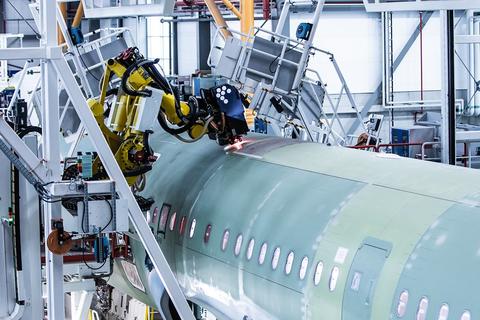
A320 Family additions: A321LR & A321neo Cabin Flex
It’s been a busy 2018 for Airbus’ growing A320 Family, with major achievements for two of this single-aisle product line’s latest variants: the extended-range A321LR and the A321neo Cabin Flex, which has expanded seating capacity thanks to optimised use of cabin space.
Airbus’ longer-range A321LR variant marked several key milestones this year leading up to its first delivery to launch customer Arkia Israeli Airlines, which occurred in November.
The A321LR allows operators the flexibility to fly long-range (LR) operations of up to 4,000nm (7,400km) and to tap into new long-haul markets, which were not previously accessible with single-aisle aircraft. In late March, the A321LR underscored its impressive range with a record-breaking flight from Mahé in the Seychelles islands to Toulouse, France – covering a total distance of 4,750 nautical miles in 11 hours.
Airbus delivered the first A321neo with the Cabin Flex configuration to Turkish Airlines in July. By applying modifications to the fuselage, it enables flexible cabin configurations for up to 240 passengers.
Compared to the previous A321 variant, the most visible modifications in the Cabin Flex configuration are a new rear section and a modified passenger door configuration, where the door located forward of the wing is removed and new overwing emergency exits in the centre section are introduced. The A321neo in Cabin Flex configuration is an option today and will become standard for all A321neos around 2020.
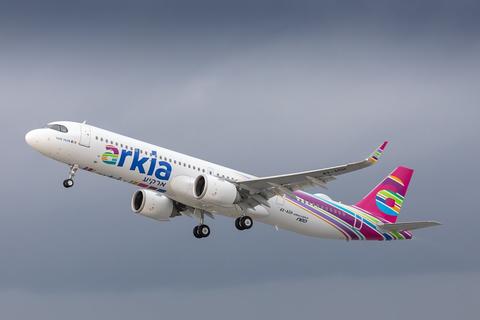
Certification milestone for the A320 “new engine option” Family
In December 2018, the A319neo “new engine option” – powered by CFM International’s LEAP-1A engine – achieved joint Type Certification from US FAA and European EASA airworthiness authorities. It follows certifications of the previous variants powered by this engine option (the A320neo in May 2016, and A321neo in March 2017). Thus, all three new engine option members of the A320 Family are certified by the international authorities to operate with the LEAP-1A powerplant.
With deliveries beginning in 2016, the A320neo Family incorporates many innovations. It offers a choice of two new-generation engine options – the LEAP-1A and Pratt & Whitney GTF™ – and integrates large fuel-saving Sharklet wingtip devices.
The A320neo Family is the world’s best-selling single-aisle product line, with over 6,200 aircraft ordered from over 100 customers by the end of 2018. The A320neo accommodates 165 passengers in two classes, or up to 194 in a high-density configuration. The shorter-fuselage A319neo seats 140 passengers in two classes or up to 160 in a high-density layout, while the longest-fuselage A321neo’s maximum certified capacity was expanded to 244 seats – all while offering unmatched comfort in each class of cabin service.
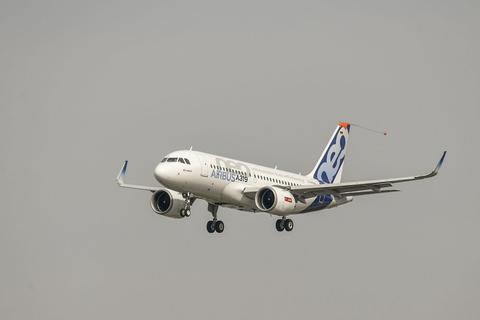
A European-Canadian partnership for the A220
A milestone partnership between Airbus and Canada’s Bombardier took effect in July with Airbus acquiring a majority stake in the C Series Aircraft Limited Partnership (CSALP). This entity manufactures and sells Bombardier’s single-aisle C Series jets: the CS100 and CS300, which are renamed the A220-100 and A220-300 as new members of Airbus’ single-aisle aircraft family.
By combining the global reach and scale of Airbus with the state-of-the-art aircraft from Bombardier, Airbus aims to unlock the potential of the A220 Family, creating significant new value for customers, suppliers, employees and shareholders. The partnership brings together two complementary product lines – the A220 Family and the A320 Family – in the 100-150 seat market segment, which is projected to require 7,000 new aircraft over the next 20 years.
A220 Family jets destined for all local and worldwide customers outside of the U.S. will be produced at the Mirabel final assembly line in Quebec, Canada, while A220 Family aircraft for U.S. markets will be produced at Airbus’ facility in Mobile, Alabama (currently home to an A320 production line). Delta Air Lines became the first U.S. carrier to take delivery of an A220 aircraft in October. In December, Air Tanzania became the first African operator – and the fifth airline globally – with an A220 Family aircraft.

BelugaXL takes to the skies
The first BelugaXL – Airbus’ next-generation super airlifter – performed its maiden flight on 19 July, initiating a flight test campaign of some 600 hours during 10 months to achieve Type Certification and entry into service in 2019.
Airbus will operate a fleet of five BelugaXLs to transport completed sections of Airbus aircraft among the company’s European production sites and to its final assembly lines in France, Germany and Spain.
As one of the largest aircraft in existence, the new-generation transporters are six metres longer and one metre wider than the five A300-600 ST Super Transporters they will replace, with a payload lifting capacity six tonnes greater.
BelugaXL will be able to carry both wings of the A350 XWB jetliner at once, instead of the single wing currently accommodated on the Beluga ST.
